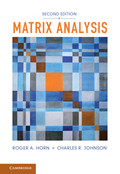The basic structure of the first edition has been preserved in the second because it remains congruent with the goal of writing “a book that would be a useful modern treatment of a broad range of topics… [that] may be used as an undergraduate or graduate text and as a self-contained reference for a variety of audiences.” The quotation is from the Preface to the First Edition, whose declaration of goals for the work remains unchanged.
What is different in the second edition?
The core role of canonical forms has been expanded as a unifying element in understanding similarity (complex, real, and simultaneous), unitary equivalence, unitary similarity, congruence, *congruence, unitary congruence, triangular equivalence, and other equivalence relations. More attention is paid to cases of equality in the many inequalities considered in the book. Block matrices are a ubiquitous feature of the exposition in the new edition.
Learning mathematics has never been a spectator sport, so the new edition continues to emphasize the value of exercises and problems for the active reader. Numerous 2-by-2 examples illustrate concepts throughout the book. Problem threads (some span several chapters) develop special topics as the foundation for them evolves in the text. For example, there are threads involving the adjugate matrix, the compound matrix, finite-dimensional quantum systems, the Loewner ellipsoid and the Loewner-John matrix, and normalizable matrices; see the index for page references for these threads. The first edition had about 690 problems; the second edition has more than 1,100. Many problems have hints; they may be found in an appendix that appears just before the index.
